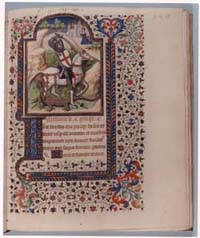Medieval Books
 Page, taken from an early 15th Century French Book of Hours, depicting St George slaying a dragon.
Page, taken from an early 15th Century French Book of Hours, depicting St George slaying a dragon.
Image by kind permission of the Master and Fellows of Trinity College Cambridge.
Manuscripts were written with quills, whose tips needed to be sharpened regularly with a knife. The medieval scribe used both hands to write: one to hold the quill, and the other to hold the knife for sharpening the quill and scraping off mistakes. The quills were dipped in inkhorns or inkwells, which contained ink made either from charcoal or from oak galls.
Manuscript books were mainly produced in Europe in the scriptoria of religious houses. There were secular illuminators and scribes who worked on a fixed charge. Books made of parchment could be on religious topics, such as the Bible or legends of saints; they could be on secular topics, such as history and romances; and they were also used as textbooks. The Bibles, stories of saints, Books of Hours, histories and romances were often beautifully illuminated with colours and gold and became luxury items that reflected the wealth and the taste of the owners. Manuscripts of learning, however, tended to be more humble, limited in decoration and colour.
Most medieval universities required the professors to deposit a master-copy of the text at the university stationers, who in turn lent out parts ( = pecia) of 10-12 sheets at time for students to copy them. This lending out of text by parts (the 'pecia' system) ensured that a small number of master copies could be circulated efficiently.